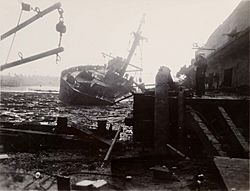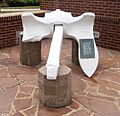Texas City disaster facts for kids
The Texas City Disaster was a huge and very serious event that happened on April 16, 1947. It was one of the biggest non-nuclear explosions ever in the United States. The disaster started when a French ship called the SS Grandcamp caught fire while docked in Texas City. The ship was carrying a lot of ammonium nitrate, which is a type of fertilizer. When this cargo exploded, it caused massive damage and killed 581 people.
Contents
What Caused the First Explosion?
The SS Grandcamp was a World War II ship that had been changed into a cargo vessel. It was loading ammonium nitrate fertilizer at a dock near some chemical factories. Around 8:00 AM on April 16, 1947, a crew member smelled smoke. He found that some bags of fertilizer were on fire in the ship's cargo hold.
He tried to put out the fire with water and a fire extinguisher. But when he asked for a hose, the ship's captain said no. The captain was worried that water would ruin the valuable cargo. Instead, he ordered the hold to be closed and steam to be released inside. This was usually a good idea for fires, but not for this type of cargo.
Ammonium nitrate can explode if it gets too hot. The fire inside the ship grew hotter and hotter. The captain then told his crew to leave the ship.
The First Big Blast
Firefighters arrived and tried to spray water on the burning ship from the dock. Many people, including schoolchildren, gathered to watch. This was a very dangerous place to be.
At 9:12 AM, the Grandcamp exploded with a huge blast. The captain and 32 of the ship's crew died. Only 10 crew members survived. More than 200 people on the dock were killed instantly.
The explosion was so powerful that people heard it 160 miles away. All the windows in Texas City shattered. Half the windows in Galveston, which is 10 miles away, also broke.
Some pieces of the ship flew almost 3 miles high before falling back down. Two airplanes flying nearby were destroyed by the flying metal. A one-ton piece of the ship's propeller shaft landed 2.5 miles away! Other parts flew as far as 5 miles.
The blast flattened 20 blocks of buildings near the water. It also destroyed 12 blocks further inland. The flying, burning pieces of the ship set fire to oil, gas, and chemical tanks at nearby factories.
Help Arrives
Firefighters and rescue workers quickly came from other cities. The Red Cross also sent a lot of help from all over the country. However, this was before jet planes, so it took time for help to arrive.
Local officials set up places for the dead. They also asked medical students to help in the hospitals, which were very busy with injured people.
The Second Explosion
The morning after the first explosion, another cargo ship called the Highflyer caught fire. This ship had been docked near the Grandcamp. It was also carrying ammonium nitrate fertilizer.
When the fire on the Highflyer seemed to be getting out of control, tugboats were called. They tried to pull the ship out of the port. This was to prevent another explosion. But the first explosion had badly damaged the Highflyer. It was stuck to another ship, the Wilson B. Keene. The tugboats could not move it.
The Highflyer then exploded. This second blast also destroyed the Wilson B. Keene. It sent more fire and deadly debris raining down on Texas City. This new shockwave and fires killed hundreds more people.
The Aftermath
The fires from both explosions were not put out until April 18. Bodies and body parts were found all over the town. The government officially listed 405 people who were identified and 63 who were not identified. Another 100 to 200 people were listed as missing. About 3,500 people were injured. This means about 4,000 people were hurt or killed in a town of only 16,000 residents.
More than 1,500 houses were destroyed. This was one-third of all the homes in Texas City. Two thousand people lost their homes. The damage to property was estimated to be at least $600 million at the time. This would be almost $6 billion today.
Lessons Learned
An official report about the disaster made several important recommendations:
- Ammonium nitrate fertilizer should be stored and handled more carefully.
- Smoking should be banned on all piers and docks.
- Communities should have plans for big disasters. These plans should help different groups work together. This includes rescue agencies, police, fire departments, hospitals, doctors, nurses, and military authorities.
Today, the people who were not identified are buried in a special cemetery. There are also monuments in Texas City to remember the disaster. These include the propeller from the Highflyer and an anchor from the Grandcamp.
Images for kids
See also
 In Spanish: Desastre de Texas City para niños
In Spanish: Desastre de Texas City para niños





